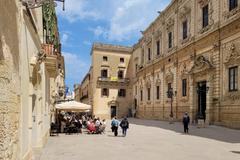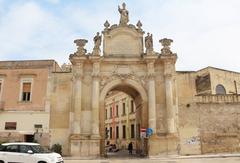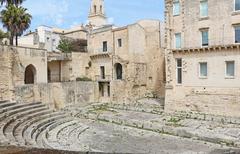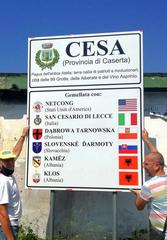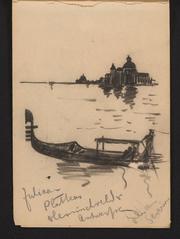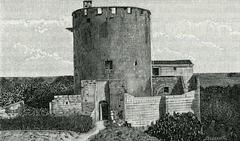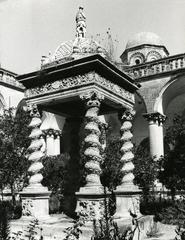Visiting Castello di Carlo V: Hours, Tickets, and History
Date: 18/07/2024
Introduction
Nestled in the heart of Lecce, Italy, the Castello di Carlo V stands as a monumental testament to the city’s rich and multi-layered history. This 16th-century fortress, commissioned by Emperor Charles V, is not only an architectural marvel but also a symbol of the geopolitical and cultural shifts that have shaped Southern Italy over the centuries. From its early Roman fortifications to its transformation under Charles V, the castle encapsulates centuries of military innovation and architectural prowess. Designed by the renowned architect Gian Giacomo dell’Acaya, the castle’s bastions and thickened walls reflect the cutting-edge military engineering of the Renaissance era. Today, the Castello di Carlo V serves as a cultural hub, housing a museum and hosting various events, making it a must-visit destination for anyone interested in history, architecture, and the enduring legacy of Lecce. For those planning a visit, knowing the visiting hours, ticket prices, and nearby attractions can enhance the experience significantly. With its strategic importance and captivating history, the Castello di Carlo V offers a unique window into the past, presenting an unmissable opportunity to delve into the rich cultural tapestry of Lecce. (Explore Castello di Carlo V - Visiting Hours, Tickets, and Architectural Marvels in Lecce)
Table of Contents
- Introduction
- Early Fortifications and the Birth of a Castle
- The Angevin and Aragonese Influence
- The Reign of Charles V and a New Era of Defense
- Gian Giacomo dell’Acaya: The Architect of Transformation
- Features of the New Fortress
- Beyond Defense: A Symbol of Power
- The Later Years and Legacy
- Visitor Information
- The Castello Today: A Window into the Past
- FAQ
- Conclusion
Exploring Castello di Carlo V - Visiting Hours, Tickets, and Historical Significance in Lecce
The Castello di Carlo V in Lecce, Italy, is not just a stunning architectural marvel but also a testament to the city’s complex and layered past. Its history is intricately woven with the ebb and flow of power, ambition, and defense strategies that shaped Southern Italy for centuries.
Early Fortifications and the Birth of a Castle
While the current structure is predominantly attributed to the 16th century, the site itself boasts a far older narrative. Archaeological evidence suggests the presence of Roman fortifications dating back to the 2nd century AD. These early structures, likely watchtowers or rudimentary defensive positions, highlight Lecce’s strategic importance even in ancient times.
During the medieval period, as Lecce grew in prominence, so did the need for more robust defenses. The Normans, who controlled Southern Italy from the 11th century, are credited with significantly strengthening the existing fortifications. They likely erected the first semblance of a castle, incorporating the remnants of the Roman structures.
The Angevin and Aragonese Influence
The 13th and 14th centuries saw Lecce change hands between the Angevin and Aragonese dynasties. Each ruling power left its mark on the castle, expanding and modifying it to suit their needs and the evolving military technology of the time. The castle served not only as a military stronghold but also as a symbol of authority and power projection in the region.
The Reign of Charles V and a New Era of Defense
The castle’s most significant transformation began in the early 16th century under the rule of Emperor Charles V. The discovery of the Americas and the rise of the Ottoman Empire had shifted geopolitical dynamics, necessitating a reassessment of defensive strategies across Europe.
Charles V, recognizing the strategic importance of Lecce as a coastal city in the Kingdom of Naples, commissioned a complete overhaul of the existing fortifications. The task was entrusted to the renowned architect Gian Giacomo dell’Acaya, a master of military architecture.
Gian Giacomo dell’Acaya: The Architect of Transformation
Dell’Acaya, drawing inspiration from the latest advancements in military engineering, conceived a radical redesign. He envisioned a fortress capable of withstanding not only traditional sieges but also the emerging threat of gunpowder artillery.
Construction began in 1539, and over the next few years, the medieval castle underwent a dramatic metamorphosis. The old structures were either incorporated into the new design or demolished to make way for a more formidable fortress.
Features of the New Fortress
Dell’Acaya’s design embraced the principles of the trace italienne, a style of fortification characterized by low, angled bastions designed to deflect cannon fire. These bastions, four in total, were strategically positioned at the corners of the fortress, providing overlapping fields of fire.
The castle walls were significantly thickened and lowered, further enhancing their resilience against artillery bombardment. A wide moat was dug around the perimeter, adding another layer of defense and making a direct assault even more challenging.
Beyond Defense: A Symbol of Power
While the Castello di Carlo V was undoubtedly a formidable military installation, it was also intended to serve as a symbol of imperial power and authority. The grand entrance, facing the city, was adorned with the Habsburg coat of arms, a clear statement of Charles V’s dominion.
The castle’s imposing presence, visible from afar, served as a constant reminder of the emperor’s reach and the strength of his rule. It was a symbol not only of military might but also of political control and stability in a region often plagued by conflict.
The Later Years and Legacy
Following its completion in 1549, the Castello di Carlo V served its intended purpose, effectively protecting Lecce from potential threats. However, as military technology continued to advance, the fortress gradually lost its strategic importance.
By the 19th century, the castle had been decommissioned as a military installation. It served various purposes over the years, including a prison and a barracks. In the 20th century, the Italian government recognized its historical and architectural significance, declaring it a national monument.
Visitor Information
For those planning a visit, the Castello di Carlo V is open to the public. The visiting hours are typically from 9:00 AM to 7:00 PM, but it’s advisable to check the official website for any changes or special closures. Tickets can be purchased at the entrance or online, with prices varying for adults, children, and groups. Guided tours are available and highly recommended for a comprehensive understanding of the castle’s history and architecture.
Travel Tips
The best time to visit the Castello di Carlo V is during the spring and autumn months when the weather is pleasant. Comfortable footwear is advised as there is a lot of walking involved. Photography is allowed, but be sure to check for any restrictions, especially in indoor areas.
Nearby Attractions
Lecce boasts a wealth of historical sites. After exploring the castle, visitors can head to the nearby Piazza del Duomo, the Roman Amphitheatre, and the Basilica di Santa Croce. Each site offers a unique glimpse into Lecce’s rich history and architectural splendor.
Accessibility
The castle strives to be accessible to all visitors. Ramps and elevators are available for those with mobility issues, and there are designated parking spots close to the entrance.
Special Events
Throughout the year, the Castello di Carlo V hosts various events, including historical reenactments, art exhibitions, and cultural festivals. These events provide additional insights into the castle’s past and its role in the community.
The Castello Today: A Window into the Past
Today, the Castello di Carlo V stands as a well-preserved example of 16th-century military architecture. It houses a museum showcasing the castle’s history and the city of Lecce’s broader cultural heritage.
Visitors can explore the castle’s ramparts, bastions, and interior spaces, gaining a tangible sense of its former strength and grandeur. The Castello di Carlo V serves as a poignant reminder of Lecce’s rich past and the forces that shaped its destiny.
FAQ
What are the opening hours of Castello di Carlo V?
The castle is typically open from 9:00 AM to 7:00 PM, but it is best to check the official website for the most current information.
Are guided tours available at Castello di Carlo V?
Yes, guided tours are available and highly recommended to fully appreciate the historical and architectural significance of the castle.
How much are the tickets for Castello di Carlo V?
Ticket prices vary depending on age and group size. It’s advisable to check the official website or purchase tickets online for the latest pricing.
Is the Castello di Carlo V accessible for visitors with disabilities?
Yes, the castle has made efforts to be accessible, including ramps and elevators for those with mobility issues.
What are some nearby attractions in Lecce?
Nearby attractions include the Piazza del Duomo, the Roman Amphitheatre, and the Basilica di Santa Croce.
Call to Action
Planning a visit to Lecce? Don’t miss the chance to explore the Castello di Carlo V and immerse yourself in its rich history. For more information, download our mobile app Audiala, check out our other related posts, or follow us on social media for the latest updates.
Conclusion
The Castello di Carlo V in Lecce is far more than just a historical monument; it is a living testament to the city’s enduring legacy and strategic importance over the centuries. From its early Roman origins and medieval transformations to its Renaissance redesign under Charles V, the castle has continually evolved to meet the needs and challenges of its time. Today, as a well-preserved example of 16th-century military architecture, it offers visitors a unique opportunity to step back in time and explore the rich history and cultural heritage of Lecce. Whether you’re fascinated by its architectural marvels, intrigued by its historical significance, or simply looking to enjoy a day out in a stunning setting, the Castello di Carlo V has something to offer for everyone. With accessible facilities, guided tours, and a variety of events throughout the year, the castle continues to play a vital role in the cultural life of Lecce. Don’t miss the chance to explore this iconic landmark on your next visit to Southern Italy. For more information, tickets, and updates, check out the official Viaggiare in Puglia website. (Visitor Guide to Castello di Carlo V - Hours, Tickets, and Tips for Exploring Lecce’s Historic Gem)
References
- Exploring Castello di Carlo V - Visiting Hours, Tickets, and Historical Significance in Lecce, 2024, Unknown Author source
- Explore Castello di Carlo V - Visiting Hours, Tickets, and Architectural Marvels in Lecce, 2024, Unknown Author source
- Visitor Guide to Castello di Carlo V - Hours, Tickets, and Tips for Exploring Lecce’s Historic Gem, 2024, Unknown Author source
